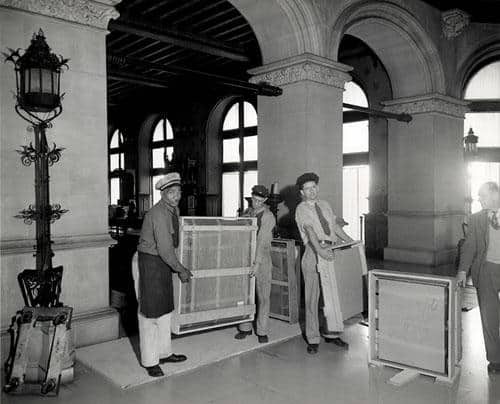Those who do not learn from history are doomed to repeat it. In the War of 1812, British troops marched into Washington, D.C. on August 24, 1814 and torched the city, setting fire to the U.S. Capitol, the President’s Mansion, and other landmarks. The events of 1814 were a reminder of what can happen in times of war.

By 1939, WWII was setting the world on fire. Events in Europe and the Far East were clear evidence of what could happen here should the war reach us. London was being shelled. Buckingham Palace had been damaged. Nazis were looting artwork from German-occupied countries. The Japanese were rampaging in the Far East and the Pacific. If the enemy could reach our lands, they would surely target our Capitol and other important national sites just as the 1814 enemy had.
David Finley, the director of the National Gallery of Art in Washington, D.C., was one of those raising the alarm over the risks to our national treasure of irreplaceable art and documents. Some of our most valuable items were concentrated in Washington. The risk of the status quo was too big. Finley was not one to sit idly by and wait for others to act. What was needed was a place far outside of D.C. where valuable items could be stored for safekeeping. He found an answer, the perfect place through his longtime friendship with Edith Vanderbilt. The Vanderbilt’s Biltmore Estate was built of brick and steel with a limestone veneer. It was practically fireproof! And its remote mountain location provided a natural shelter against the ravages of war.
Three weeks after the bombing of Pearl Harbor, 62 paintings (including the George Washington portrait by Gilbert Stuart) and 17 sculptures from the National Gallery of Art were crated and loaded onto a train for the trip through the foothills and mountains to the Biltmore Estate. Millions of dollars worth of art, including pieces by Vermeer, Van Dyck, Goya, and Rembrandt, arrived in Asheville in the middle of a snowstorm. The paintings were stored in an unfinished room on the ground floor at Biltmore. The estate retrofitted the room, installing steel vaulted doors and vertical steel shelving from which the paintings could be hung. They also added draperies over those steel vaulted doors so nothing would look out of place. The art remained at Biltmore until 1944, when the wartime threat had begun to wane. The National Gallery issued press releases and invited photographers to shoot the art being loaded onto moving vans for the return journey to Washington. But until then, the war-time plan to save our treasures remained a closely held secret.
We may never know the full extent of the WWII relocation of our art and precious documents. The Biltmore story focused on the National Gallery of Art, but what about the Library of Congress and government agencies? There are rumors that subterranean Asheville may have also played a safekeeping role and that some artifacts may yet remain in caverns lost or forgotten.
